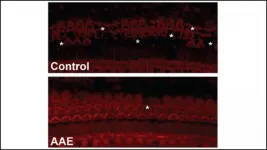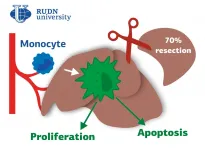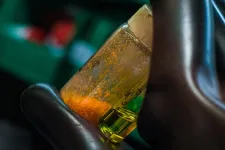(Press-News.org) A commonly studied perovskite can superfluoresce at temperatures that are practical to achieve and at timescales long enough to make it potentially useful in quantum computing applications. The finding from North Carolina State University researchers also indicates that superfluorescence may be a common characteristic for this entire class of materials.
Superfluorescence is an example of quantum phase transition - when individual atoms within a material all move through the same phases in tandem, becoming a synchronized unit.
For example, when atoms in an optical material such as a perovskite are excited they can individually radiate light, create energy, and fluoresce. Each atom will start moving through these phases randomly, but given the right conditions, they can synchronize in a macroscopic quantum phase transition. That synchronized unit can then interact with external electric fields more strongly than any single atom could, creating a superfluorescent burst.
"Instances of spontaneous synchronization are universal, occurring in everything from planetary orbits to fireflies synchronizing their signals," says Kenan Gundogdu, professor of physics at NC State and corresponding author of the research. "But in the case of solid materials, these phase transitions were thought to only happen at extremely low temperatures. This is because the atoms move out of phase too quickly for synchronization to occur unless the timing is slowed by cooling."
Gundogdu and his team observed superfluorescence in the perovskite methyl ammonium lead iodide, or MAPbI3, while exploring its lasing properties. Perovskites are materials with a crystal structure and light-emitting properties useful in creating lasers, among other applications. They are inexpensive, relatively simple to fabricate, and are used in photovoltaics, light sources and scanners.
"When trying to figure out the dynamics behind MAPbI3's lasing properties, we noticed that the dynamics we observed couldn't be described simply by lasing behavior," Gundogdu says. "Normally in lasing one excited particle will emit light, stimulate another one, and so on in a geometric amplification. But with this material we saw synchronization and a quantum phase transition, resulting in superfluorescence."
But the most striking aspects of the superfluorescence were that it occurred at 78 Kelvin and had a phase lifetime of 10 to 30 picoseconds.
"Generally superfluorescence happens at extremely cold temperatures that are difficult and expensive to achieve, and it only lasts for femtoseconds," Gundogdu says. "But 78 K is about the temperature of dry ice or liquid nitrogen, and the phase lifetime is two to three orders of magnitude longer. This means that we have macroscopic units that last long enough to be manipulated."
The researchers think that this property may be more widespread in perovskites generally, which could prove useful in quantum applications such as computer processing or storage.
"Observation of superfluorescence in solid state materials is always a big deal because we've only seen it in five or six materials thus far," Gundogdu says. "Being able to observe it at higher temperatures and longer timescales opens the door to many exciting possibilities."
The work appears in Nature Photonics and is supported by the National Science Foundation (grant 1729383). NC State graduate students Gamze Findik and Melike Biliroglu are co-first authors. Franky So, Walter and Ida Freeman Distinguished Professor of Materials Science and Engineering, is co-author.
INFORMATION:
Note to editors: An abstract follows.
"High Temperature Superfluorescence in Methyl Ammonium Lead Iodide"
DOI: 10.1038/s41566-021-00830-x
Authors: Gamze Findik, Melike Biliroglu, Dovletgeldi Seyitliyev, Juliana Mendes, Andrew Barrette, Hossein Ardekani, Lei Lei, Qi Dong, Franky So, Kenan Gundogdu, North Carolina State University
Published: June 21, 2021 in Nature Photonics
Abstract:
Light-matter interactions can create and manipulate collective many-body phases in solids, which are promising for the realization of emerging quantum applications. However, in most cases these collective quantum states are fragile, with a short decoherence and dephasing time, limiting their existence to precision tailored structures under delicate conditions such as cryogenic temperatures and/or high magnetic fields. In this work, we discovered that the archetypal hybrid perovskite, MAPbI3 thin films, exhibit such a collective coherent quantum many-body phase, namely superfluorescence, at 78 K and above. Pulsed laser excitation first creates a population of high energy electron-hole pairs, which quickly relax to lower energy domains and then develop a macroscopic quantum coherence through spontaneous synchronization. The excitation fluence dependence of the spectroscopic features and the population kinetics in such films unambiguously confirm all the well-known characteristics of superfluorescence. These results show that the creation and manipulation of collective coherent states in hybrid perovskites can be used as the basic building blocks for quantum applications.
All plant cells obtain their energy mainly from two organelles they contain - chloroplasts (responsible for photosynthesis) and mitochondria (responsible for the biochemical cycle of respiration that converts sugars into energy). However, a large number of a plant cell's genes in its mitochondria and chloroplasts can develop defects, jeopardising their function. Nevertheless, plant cells evolved an amazing tool called the RNA editosome (a large protein complex) to repair these kinds of errors. It can modify defective messenger RNA that result from defective DNA by transforming (deamination) of certain mRNA nucleotides.
Automatic error correction in plant cells
Automatic error correction in plants was discovered about 30 years ago by a team headed by plant physiologist Axel Brennicke ...
While the LGBTQ+ community has seen significant advancements in legal rights, political representation and social acceptance over recent years, mental and physical health disparities still exist for queer Americans - and are even worse among younger generations, says a new study from Michigan State University.
In the first-ever population-based national study comparing mental and physical health of lesbian, gay and bisexual (LGB) Americans to their straight counterparts, MSU sociologist Hui Liu and research partner Rin Reczek, professor of sociology from Ohio State University, found that when compared to their straight counterparts, LGB Millennials have worse health disadvantages than their older peers, though disparities persist throughout older generations as ...
All coronaviruses produce four primary structural proteins and multiple nonstructural proteins. However, the majority of antibody-based SARS-CoV-2 research has focused on the spike and nucleocapsid proteins. A study published in PLOS Biology by Anna Heffron, Irene Ong and colleagues at the University of Wisconsin-Madison, USA, suggests that immune responses may develop against other proteins produced by the SARS-CoV-2 virus.
The efficacy of spike protein-based vaccines is variable and not everyone infected with SARS-CoV-2 produces detectable antibodies against the spike or ...
In a new study published today in the American Journal of Human Genetics, researchers announced the development of a new method to increase the utility and equity of large genetic databases. The research was conducted by Audrey Hendricks, an associate professor of statistics at the University of Colorado Denver (CU Denver).
Summix, the new method developed by Hendricks and her team of CU Denver undergraduate and graduate students, estimates the genetic ancestry in databases and adjusts the information to match the ancestry of a person or sample of people. This method leads large genetic databases to become more useful for people of various ancestries such as African American or Latinx, as they are underrepresented in genetic ...
Every day, our bodies face a bombardment of UV rays, ozone, cigarette smoke, industrial chemicals and other hazards.
This exposure can lead to free-radical production in our bodies, which damages our DNA and tissues. A new study from West Virginia University researcher Eric E. Kelley--in collaboration with the University of Minnesota--suggests that unrepaired DNA damage can increase the speed of aging.
The study appears in the journal Nature.
Kelley and his team created genetically-modified mice with a crucial DNA-repair protein missing from their hematopoietic stem cells, immature immune cells that develop into white blood cells. Without this ...
Broadband sounds embedded with short pauses can maintain temporal sound processing in a mouse model of hearing loss, according to new research published in eNeuro.
Hearing loss treatments supplement auditory system function but don't repair it. However a new intervention -- playing broadband sounds during the onset of hearing loss -- may be able to prevent the damage from ever occurring. Augmented auditory environments have been able to preserve auditory processing of a wide range of sound frequencies in mice models. In a new study, Dziorny et al. modified the traditional paradigm and preserved the processing of time-related, or temporal, sound features which are vital for understanding speech.
The research team exposed mice with congenital hearing loss to ...
DURHAM, N.C. - In the fight against viruses, antibodies have the potential to either block infection or enable infection and make the disease worse, leading to concern about their use as a therapy for COVID-19.
In a study published in the journal END ...
RUDN University doctors found out what role macrophages play in the recovery of the liver after the removal of its significant part. The results are published in the journal Biomedicine & Pharmacotherapy.
The liver in mammals is the most regenerative internal organ. It can restore the original size from as little as 25% of the preserved tissue. An important role in this process is played by macrophages. These are the cells that can engulf and digest particles. It is known, for example, that if the liver is affected by foreign substances, including drugs, macrophages migrate to the liver, absorb harmful microorganisms and dead cells, cause inflammation and thus contribute to the restoration of the organ. However, it is still unknown unambiguously how macrophages affect the ...
Nearly a third of Americans who arranged for paid care for an older person or someone with dementia employed workers who were not hired through a regulated agency, according to a new RAND Corporation study.
Individuals who hired gray market caregivers were less likely to be employed and more likely to also use unpaid care for their family members. In addition, people who lived in rural areas had an almost five-times higher odds of arranging dementia care through gray markets as compared to those who lived in urban areas.
The study is the first national survey to probe the use of gray market care for older adults and people with dementia. The findings ...
HOUSTON - (June 21, 2021) - Rice University engineers have created microscopic seeds for growing remarkably uniform 2D perovskite crystals that are both stable and highly efficient at harvesting electricity from sunlight.
Halide perovskites are organic materials made from abundant, inexpensive ingredients, and Rice's seeded growth method addresses both performance and production issues that have held back halide perovskite photovoltaic technology.
In a study published online in Advanced Materials, chemical engineers from Rice's Brown School of Engineering describe how to make the seeds and use them to grow homogenous thin films, highly sought ...




